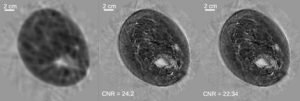Ultrasound Computed Tomography
Ultrasound Computed Tomography (USCT) is an imaging technique that utilizes tomographic principles to obtain quantitative estimates of acoustic properties such as speed-of-sound, density, and acoustic attenuation. USCT has a number of potential applications, including breast cancer screening. It has a number of advantages over existing imaging modalities. Compared with mammography, it is radiation-free, breast-compression-free, and relatively inexpensive. Compared with conventional B-mode ultrasound, it produces images with a large field-of-view whose quality is independent of the skill of the operator.
Most image reconstruction methods in USCT are based on approximate solutions to the acoustic wave equation, which ignore higher-order diffraction effects. This can result in reconstructed images with poor resolution. This problem can be overcome through the use of waveform-inversion-based image reconstruction methods that directly seek the solution of the acoustic wave equation. However, this approach is often computationally very expensive. To circumvents this problem, we proposed the efficient algorithm refer as waveform inversion with source encoding (WISE). We also proposed the dual averaging method to improve the effectiveness of regularization.
Our work focuses on advanced image reconstruction algorithms and accurately modeling of the underlying physics of USCT imaging systems. We accomplish this through the use of optimization-based image reconstruction algorithms that leverage the latest work in stochastic optimization, machine learning, and computational acoustics. This project represents a collaboration with Dr. Neb Duric and his team.

(a) Sound speed distribution of the numerical breast phantom; (b) Images reconstructed by use of the WISE method; (c) the bent-ray model-based sound speed reconstruction method; (d) Profiles of the reconstructed images

Sound speed images of a breast cancer patient reconstructed by use of ray-less adjoint state method(left), WISE method(middle) and weighted RDA method with a wavelet-based penalty and regularization parameter. (right)
Publication
- Wang, K., Matthews, T., Anis, F., Li, C., Duric, N., & Anastasio, M. A. (2015). Waveform inversion with source encoding for breast sound speed reconstruction in ultrasound computed tomography. IEEE transactions on ultrasonics, ferroelectrics, and frequency control, 62(3), 475-493.
- Matthews, Thomas P., Kun Wang, Cuiping Li, Neb Duric, and Mark A. Anastasio. “Regularized dual averaging image reconstruction for full-wave ultrasound computed tomography.” IEEE transactions on ultrasonics, ferroelectrics, and frequency control, 64, no. 5 (2017): 811-825.
- Anis, Fatima, Yang Lou, André Conjusteau, Richard Su, Tanmayi Oruganti, Sergey A. Ermilov, Alexander A. Oraevsky, and Mark A. Anastasio. “Investigation of the adjoint-state method for ultrasound computed tomography: a numerical and experimental study.” In Photons Plus Ultrasound: Imaging and Sensing 2014, vol. 8943, p. 894337. International Society for Optics and Photonics, 2014.
- Li, Fu, Umberto Villa, Nebojsa Duric, and Mark A. Anastasio. “Investigation of an elevation-focused transducer model for three-dimensional full-waveform inversion in ultrasound computed tomography.” In Medical Imaging 2022: Ultrasonic Imaging and Tomography, vol. 12038, pp. 206-214. SPIE, 2022.